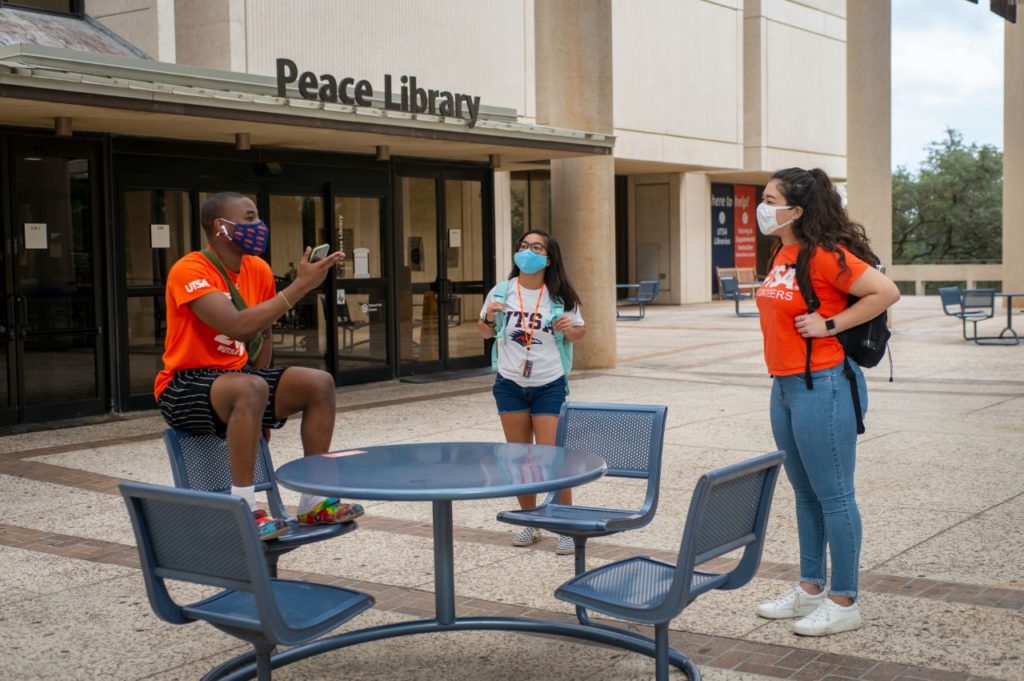Creating Campus Connections – Online and In-Person
in Blog Post
“I am a little nervous coming back in person because of covid but I am excited to be more engaged with my classes because I found it pretty hard to learn on zoom”
– Louis N.
Electrical and Computer Engineering, Junior
“I feel safe coming back to school in person because I know to keep my distance and wear my mask”
– Kristlyn S.
Environmental Science, Sophomore
M. Sidury Christiansen, Ph.D., Next-Gen Provost Fellow and Associate Professor in COEHD’s Department of Bicultural Bilingual Studies says that conversations during office hours have transformed and become a way for students to talk about themselves – how they’re feeling and the things that worry them.
From Sidury:
“I just had a student a few days ago that had a simple question, which I answered in under two minutes; however, the visit lasted over 5 minutes because the student was sharing how they were feeling lonely and office hours were good because she had someone to talk to.
Students and faculty have been working remotely from their offices, homes, and dorm rooms for weeks after a long winter break. After that amount of time, it’s natural for people to crave connection with their colleagues, friends, and mentors. Despite the fact that her courses are exclusively in an online modality, some of Sidury’s students expressed disappointment that they wouldn’t be getting together in-person.
“Whatever the modality, we are all in desperate need of connection,” says Sidury. “The fun part of learning is always those connections we build with our peers and there is no substitute for the camaraderie that comes with this co-construction of knowledge that group work or peer activities provides.”

To help speed up and promote those important connections, Sidury designed group projects that facilitated student and faculty interactions that would work in whatever modality the students was most comfortable engaging in.
Sidury breaks down what she does to facilitate student connections:
- Introductions: At the beginning of the semester, I ask students to introduce themselves on the discussion board with a photo/video and a small description that includes their favorite hobby or what they are passionate about. This small activity allows students to identify classmates with whom they share interests.
- Group activity assignment: Based on a topic provided, students sign up for a group project. The project consists on having them design a synchronous/asynchronous activity for their classmates to engage with the readings in the module. I provide a detailed assignment sheet that helps students organize themselves and meet several times before they meet with me for revision and then approval of their activity. I have students create virtual escape rooms, online mazes, mock Ted Talks, and other creative ways to engage their classmates. This type of group work allows them to always be in touch with other classmates.
- Offer extra credit points for collaborative notetaking: This is not a formal assignment, but I provide students with reading response templates where two or more students from the class can get together to share notes and exchange information via collaborative file sharing services. I then give one or two extra credit points for collaboration.
Additional Resources
Again, not all students may be comfortable collaborating in-person but that shouldn’t be a barrier to creating connections. Academic Innovation has a variety of resources to help faculty find ways to collaborate in a hyflex environment. Use dynamic digital tools like Padlet for immediate multimodal conversations and PlayPosit for asynchronous interactive videos or live broadcast to help bridge the gap between modalities.
Offline, students and faculty also have access to on-campus spaces that can accommodate in-person + online collaboration. The Academic Success District’s Outdoor Learning Environments are bookable spaces with integrated technology that facilitates group work on-site or online. The John Peace Library has numerous indoor study and breakout spaces for group work as well.
“There are some hidden gems on campus,” says José Escobedo, a COLFA senior and Student Government President. “I’m majoring in political science but I still like to work with my friends at the tables outside the Makerspace in the College of Engineering and Integrated Design because I enjoy the energy you feel from seeing what’s going on inside the labs.”
The need to create campus connections – relationships that often last well-beyond graduation – isn’t specific to modality. The pandemic accelerated the shift toward working in online spaces but humans are still catching up on how that impacts social interactions. At UTSA, faculty play a critical role in helping students shape their college experience regardless of modality.
To learn more about collaboration tools and resources, visit Academic Innovation’s Teaching, Learning & Digital Transformation website.
Tags: campus connection, collaboration spaces, Collaboration tools, collaborative notetaking, group assignments, in person, online, student connection

